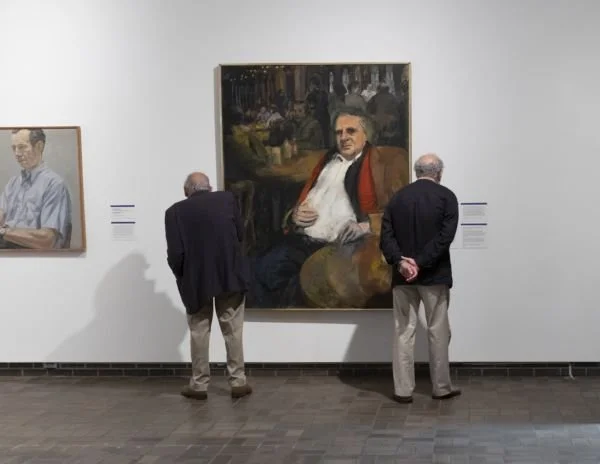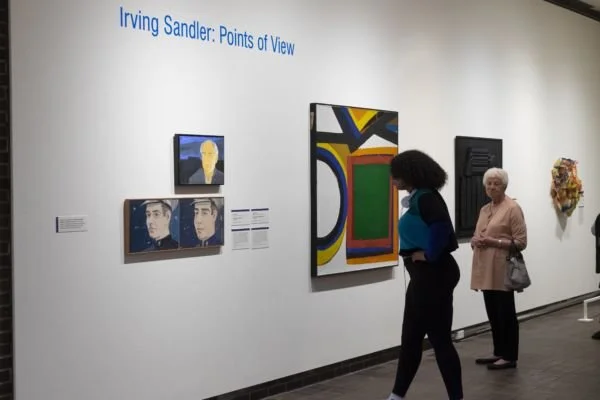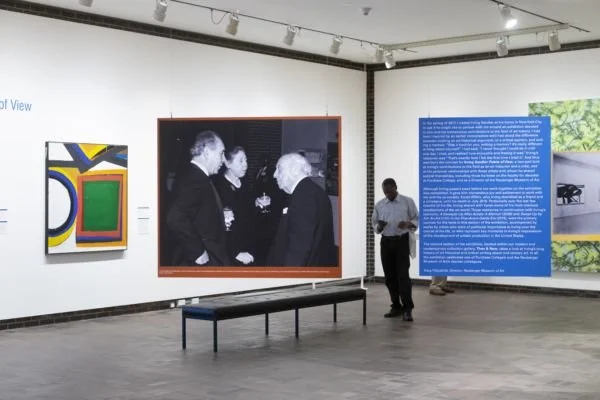Irving Sandler: Points of View
Installation view from “Irving Sandler: Points of View” at the Neuberger Museum of Art, featuring Paul Georges, “At the Cedar Street Tavern.” Photograph by Ed Cody.
By Karen Wilkins | October 25, 2018
A collaborative project begun with Sandler prior to his death in June 2018, Irving Sandler: Points of View, now at the Neuberger Museum of Art at Purchase College, considers his participation in and influence on the disciplines of art criticism, contemporary art, and teaching within the context of his personal and professional relationships with the artists, scholars, critics, and teachers he taught and from whom he learned.
The exhibition, on view through December 23, 2018, is co-curated by Tracy Fitzpatrick, Director of the Neuberger Museum, with Karen Wilkin, independent curator and art critic, who reflects on Sandler's legacy here.
IRVING SANDLER 1925-2018
Irving Sandler’s death in June, a few weeks short of his 93rd birthday, deprived the art world of a legend. For more than six decades, from the 1950s to the present, Sandler played an important role of the evolving story of American vanguard painting and sculpture, as a friend of artists and a frequent studio visitor, as director and founder of alternative galleries, as art critic, as professor of art history, as museum director, and, above all, as witness and chronicler of the changing desiderata of the moment. Until the very end of his long, rich life, Sandler was a vivid presence, seemingly ubiquitous, tirelessly attending exhibitions, panels, and lectures, taking exhaustive notes in his tiny handwriting and asking probing, informed questions. It hardly needs saying that the books that he distilled from his insider’s experience, four volumes that together provide a history of (mostly) American art after World War II, have been required reading for several generations of scholars, collectors, and those with even a casual interest in these tumultuous years. The Triumph of American Painting: A History of Abstract Expressionism; The New York School: The Painters and Sculptors of the Fifties; American Art of the 1960s; and Art of the Postmodern Era: From the Late 1960s to the Early 1990s are notable for their lively evocation of Sandler’s deep, intimate knowledge of their subjects and their blessedly jargon-free, lucid prose. The same can be said of the informal, informative memoirs he published in his last decades, A Sweeper-Up After Artists and Swept Up By Art (He always credited this deceptively effortless clarity to what he called the “brilliant and brutal editing” of his wife, the distinguished historian of medieval art, Lucy Freeman). His last book, a novel set in the art world of the 1950s and 1960s is due to be published soon.
Sandler’s profound engagement with the art of his time began accidentally. Born in New York and raised in Hartford, Winnipeg, and Philadelphia, where his family moved because of his father’s work, Sandler enlisted in the Marine Corps at 17. Sent to college by the Marines, in an officer’s training program, he attained the rank of second lieutenant, but was never sent overseas. Although he liked to boast that he hadn’t exercised since being honorably discharged from the service, Sandler remained extremely proud of having been a Marine, a period of his life memorialized by his friend Alex Katz in a double portrait. He had asked Katz why he didn’t paint people in their “moments of glory” and when the artist asked what Sandler’s moment of glory was, he replied “Being a marine.” He always pointed out that the enlisted man’s uniform he wears in the portrait, supplied by Katz, was inaccurate: “I was an officer.”
Installation view from “Irving Sandler: Points of View” at the Neuberger Museum of Art, featuring works by Alex Katz and Al Held. Photograph by Ed Cody.
Sandler’s epiphany occurred in 1952, when he was pursuing a Ph. D in American history at Columbia University, impoverished, and losing interest in his subject. He frequented the Museum of Modern Art, to which he had a pass, using the garden as an oasis, and looking at the art without special interest. One day, Franz Kline’s 1950 black and white abstraction, Chief, suddenly compelled Sandler’s attention. As he described it in A Sweeper-Up After Artists, “It was the first work of art that I really saw, and it changed my life….Chief began my life-in-art, the life that has really counted for me.” Soon after, Sandler was befriended by Angelo Ippolito, a second-generation Abstract Expressionist, and became a regular at the Cedar Tavern, where both card-carrying and aspiring Abstract Expressionists from several generations pondered the necessity of abstraction, the importance of authenticity, the requirement that art not depict what could be seen but reveal the unseen, and many more thorny issues, in intense debates fueled by ample amounts of alcohol, tobacco, and ambition. Although he was a generation younger than the majority of the Abstract Expressionists, Sandler became part of their inner circle, visiting studios and attending their events. Eventually he became the woefully underpaid “manager” of the cooperative 10th
Street Tanager Gallery, which placed him in the thick of the younger downtown avant-garde and led to lifelong friendships with artists of his own generation such as Katz, Al Held, and Philip Pearlstein. Over the ensuing decades, Sandler seems to have gotten to know everyone; more importantly, he made it his mission to carefully record everything he could about what the artists he followed were making, exhibiting, and talking about. Held termed him “our Boswell.”
Despite his deep immersion in the art world he wrote about, despite his significant friendships, and despite the eye-witness quality of his writings, Sandler always maintained that he strove for objectivity in his four volumes, choosing the artists he included, he told me, not as much because of his own predilections as because of consensus – what the larger art world deemed important, at a given moment. Yet Sandler’s love of the entire art-making milieu and his affection for particular artists comes through in all his writings, however dispassionate and non-judgmental their tone.
Installation view from “Irving Sandler: Points of View” at the Neuberger Museum of Art, featuring an archival photo of Irving and Lucy Sandler with Roy R. Neuberger, founding patron of the Neuberger. Photograph by Ed Cody.
What’s perhaps most remarkable, Sandler’s curiosity, appetite, and enthusiasm was neither focused on a single approach, nor restricted to artists of his own generation, nor to the older abstract artists whose work had first stimulated his passionately engaged “life-in-art.” As his memoirs and the art that he and his wife lived with attest, his interest was captured, over the years, by the work of artists as diverse in age and in ways of working as Joan Mitchell, Louise Nevelson, Judy Pfaff, and Robert Berlind, to name just a few of the many whom Sandler followed closely and who became part of his astonishing circle of friends. To honor this catholicity of taste and to celebrate Sandler’s long, extraordinary life, as well as his many years of teaching at SUNY Purchase and his stint as director of the Neuberger Museum of Art, Tracy Fitzpatrick, the Neuberger’s director, and I began working last winter on a two section exhibition intended as a kind of “visual Festschift” for Irving Sandler. For one section, we selected works from the Neuberger’s collection by artists he had written about in particular depth. For the other, which we thought of as a “portrait,” we focused on works by artists Sandler was specially close to, such as Berlind, represented mainly by paintings from his own collection, such as a spectacular early Held and portraits by Katz and Pearlstein, including the one of the art critic as a Marine. We created extended labels for both sections, with apposite quotes from Sandler’s writings. He was thrilled and excited by the project, and shared wonderful stories with us about the works he lived with. The last time I saw Irving, in fact, less than a week before his death, he wanted only to talk about the show. Our only regret is that he did not live to see the exhibition installed at the Neuberger. But we hope he would approve of it, as a fitting memorial to his long “life-in-art.”



